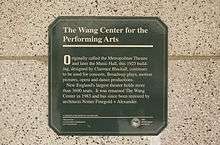Wang Theatre
 | |
| Former names |
Metropolitan Theatre (1925-1962) Music Hall (1962-1980) |
|---|---|
| Address | 270 Tremont St. |
| Location | Boston, Massachusetts |
| Public transit |
Tufts Medical Center (Orange Line) |
|
Metropolitan Theatre | |
   | |
| Coordinates | 42°21′1″N 71°3′53″W / 42.35028°N 71.06472°WCoordinates: 42°21′1″N 71°3′53″W / 42.35028°N 71.06472°W |
| Built | 1923 |
| Architect | Blackall,Clapp & Whittemore; Multiple |
| Architectural style | Renaissance |
| MPS | Boston Theatre MRA |
| NRHP Reference # | [1] |
| Added to NRHP | December 9, 1980 |
| Owner | Citi Performing Arts Center |
| Operator | Citi Performing Arts Center |
| Type | Theatre |
| Capacity | 3,500 |
| Opened | 1925 |
| Website | |
|
www | |
The Wang Theatre (est. 1983) of Boston is located in a historic 1925 building that was originally the Metropolitan Theatre, and later the Music Hall. It was designed by Clarence Blackall and is located at 252-272 Tremont Street in the Theatre District. The business is operated as part of the Citi Performing Arts Center. The building was also known as the Metropolitan Center.[2] The theatre was designated as a Boston Landmark by the Boston Landmarks Commission in 1990.
Metropolitan Theatre
The structure was originally known as the Metropolitan Theatre when it opened in 1925.[3] The Metropolitan Theatre was developed by Max Shoolman and designed by architect Clarence Blackall, with the assistance of Detroit theatre architect C. Howard Crane. It seats more than 3,600 people.
Music Hall
In 1962 it became the home of the Boston Ballet and was renamed the Music Hall. During the 1960s and 1970s, audiences could see the Stuttgart Opera, the Metropolitan Opera, Bolshoi Ballet and Kirov Ballet as well as popular movies and performing artists. With time though, they could no longer attract the large touring companies because of the size of their stage as well as their outdated production facilities. Converted to a non-profit center in 1980 and renamed the Metropolitan Center,[3] they were able to attract theatrical performances again.
Wang Center

In 1983, Dr. An Wang made a very large donation and the Wang Center was born.[4] From 1989 - 1992, $9.8 million was raised to restore the Theatre to "its glory days of the 1920s".[5] Boston based architecture firm Finegold Alexander + Associates Inc restored the theatre with Conrad Schmitt Studios performing the elegant decoration, gilded moldings, murals, scagliola and marbleized surfaces.[6]
In 2008, the Citi Performing Arts Center announced a co-booking arrangement with The Madison Square Garden Company for the Wang Theatre.[7]
The lobby was used in the movies American Hustle, for the live band performance and casino scenes, and The Witches of Eastwick, as part of the house in which Jack Nicholson's character lived. It was an also used for numerous scenes in the ABC TV pilot Gilded Lilys.[8]
See also
External links
| Wikimedia Commons has media related to The Wang Center. |
- City of Boston, Landmarks Commission. The Wang Center Study Report, 1990
References
- ↑ National Park Service (2008-04-15). "National Register Information System". National Register of Historic Places. National Park Service.
- ↑ "Improvements in Evidence at the Wang Center Dedication", Boston Globe, December 8, 1983
- 1 2 Arthur J. Singer and Ron Goodman (2011). "Metropolitan Theatre". Boston's Downtown Movie Palaces Images of America. Arcadia Publishing. ISBN 9780738576312.
- ↑ "Met Center gets a $4m Gift from the Wang Family", Boston Globe, June 3, 1983
- ↑ Wang Theatre History
- ↑ Project info
- ↑ Waddell, Ray (2008-08-07). "MSGE Expands Boston Footprint". Billboard.
- ↑ The Witches of Eastwick
